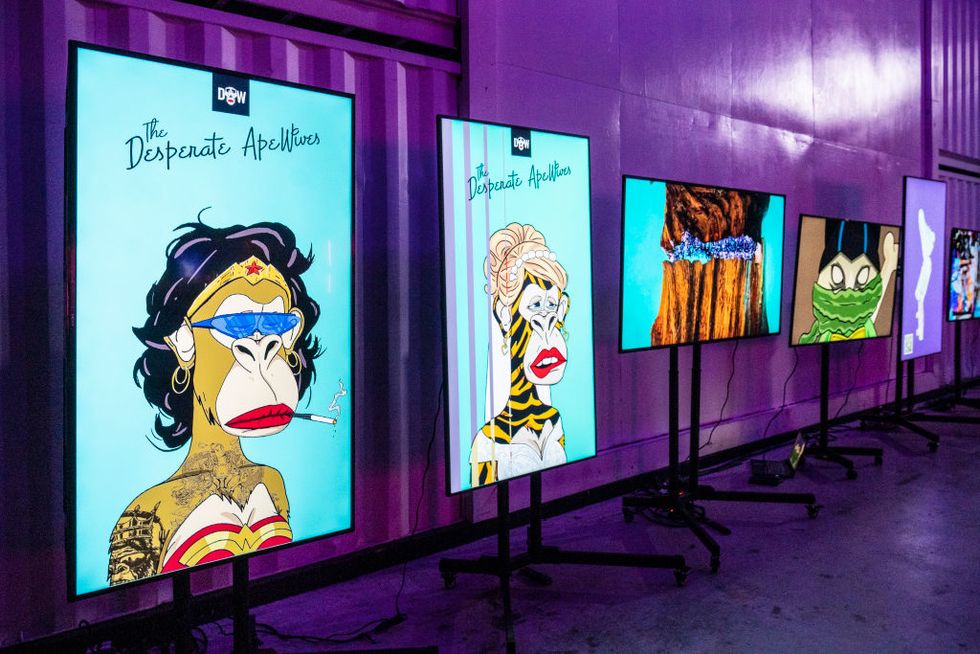What are NFTs? Non-fungible tokens explained

If you’ve heard the term non-fungible token (NFT) but still aren’t sure what one is — or why anyone would buy one — you’re not alone. Here we break down how these digital assets work and whether or not they are worth investing in.
Meet the expert: Andrew Klein is SVP of Web3 Brand Strategy and Innovation at Publicis Media. An NFT expert and innovator, he launches digital collectible experiences for dozens of brands, artists and creators.
What is an NFT?
In the simplest terms, NFTs are unique digital collectibles, such as drawings or music, which exist on blockchain technology and can be bought and sold as assets.
More from Good Housekeeping

“These are not just images of digital art that you can right-click and save, but contracts that say that you, as the owner, can use to unlock something special,” Klein explains. That something special could be membership access, a cool benefit or entry to digital or real experiences.
But let’s back up a bit: What is a blockchain? The underlying technology on which NFTs are built and stored, a blockchain is a peer-to-peer decentralized distributed database that can handle transaction records for a digital asset. While there are different blockchains, the Ethereum blockchain is where many NFTs reside.
Fungible cryptocurrencies like Bitcoin are also secured on blockchain technology, but a non-fungible token, unlike its fungible counterpart, represents a unique asset owned by a specific person, like a physical work of art. While a fungible asset, such as Bitcoin, can be exchanged for an identical item at a known rate and then easily divided into smaller units (e.g., a dollar can be divided into quarters, dimes, nickels, or pennies), one does not have -fungible token a unique identifier. It cannot be exchanged for anything other than one for one, as it is
irreplaceable and cannot be broken down into smaller units. However, NFTs are easily transferable and allow for reliable ownership of digital content.
How do you create an NFT?
To create an NFT, you first need a specific digital resource. Then you create a unique, one-of-a-kind digital signature so you can buy and sell NFTs for money, crypto, or any other asset. The initial purchase of an NFT is referred to as minting. It places the NFT in a specific location on a blockchain. Most users choose an NFT marketplace for minting.
What are some examples of NFTs?
Everything digital can be minted, from digital artwork to videos to GIFs to tweets (fun fact: Twitter co-founder Jack Dorsey sold his first ever tweet as an NFT for nearly $3 million). A few examples: Nike acquired NFT company RTFKT to sell digital sneakers, Mattel partnered with Toekenz for family-focused collectibles, and ATP (the governing body of men’s professional tennis) partnered with Art Blocks Engine and Martin Grassier to create data-rich digital art representations of remarkable tennis shots.
Probably one of the most historic NFT auctions was when digital artist Beeple sold artwork at Christie’s auction house for $69 million. Two better-known NFT collections that helped inspire momentum in the digital art space are Cryptopunks, which consists of 10,000 uniquely generated characters, and Bored Ape Yacht Club (colloquially referred to as BAYC or just Bored Apes), a limited digital art collection featuring cartoon monkeys that are algorithmically generated.
What are NFTs used for?
Aside from being able to buy and sell NFTs, many come with unique benefits. “If you’re into sports, you can buy a digital collectible of your favorite team or athlete to get access to VIP seats and signed merchandise,” says Klein. Sports not your thing? Buy a collectible from your favorite artist to be guest-listed in live and virtual shows. Do you have a favorite fashion brand? You can collect their token to access exclusive “holder only” sales of limited edition items and discounts that exceed the regular benefits of the loyalty program.
Are NFTs worth investing in?
Like many risky investments, the expert consensus is that it depends.
Because of their novelty and the fact that an NFT’s value is determined by how much someone is willing to pay, it’s really a question of whether you have the money to experiment with whether digital art (or any other asset) has personal value to you and how long you are comfortable holding your investment in an NFT, among other market factors.
While it is important to realize and accept that you may lose money on your NFT or that you may not be able to resell it at all, Klein believes that buying NFTs is no more risky than buying any preferably another type of collectible. “If you come across a digital collectible you like or think is interesting, why not?” he says. “It’s human nature to collect things! People collect art, vinyl records, comics, sneakers, Pokemon cards and thousands of other items. As our time and attention are increasingly spent on digital things, it’s no surprise that digital collectibles have emerged as the next big thing to have.”
Klein also points out that in some cases you may not even have to purchase an NFT; You can serve digital collectibles from your favorite brands or by attending special events. “These have become known as POAPs, Proof of Attendance Protocol tokens, which act as digital ticket stubs, Playbills or other digital mementos of the occasion,” he says. “In some cases, these can unlock special digital experiences and future rewards.”
How do you buy NFTs?
Once an NFT has been minted, users can put it up for sale. Most of the time, to buy an NFT, you need a crypto wallet and cryptocurrency (but in some cases, you may only need a credit or debit card).
A digital wallet is where your NFT and cryptocurrency will be stored when purchased or transferred. Klein explains that digital wallets are “software-like apps that store your digital collectibles and allow you to buy, sell, trade and store your digital items and NFTs.” Since not all wallets support all blockchains, you should check for compatibility before purchasing an NFT. And just like we have multiple accounts for different apps or services, you may need or want more than one digital wallet.
To get started, check out popular Ethereum-compatible crypto wallets like Coinbase Wallet or Metamask, as well as NFT exchanges like Rarible or OpenSea. Klein also recommends a few approaches that don’t require advanced wallet setups or hardware:
- OneOf has a wide selection of entertainment-driven collectibles that can provide access to events and artists.
- Sweet features collectibles from some of the top NBA and F1 racing teams that provide unique access to IRL perks and rewards.
- NiftyGateway is a great place to buy digital art collectibles from the world’s leading creators and artists, and they can be paid by credit card.
- Cryptoys has partnered with Mattel to offer Masters of the Universe (He-man/She-Ra) digital toys you can collect, play and interact with virtually.
The bottom line
While terms like NFT, blockchain and cryptocurrency may sound like gibberish, they are undoubtedly becoming part of the lexicon. “Don’t let these new words scare you from participating in the next era of the Internet experience,” says Klein. “Remember there was a time not so long ago when the world wide web, email, text messaging, file sharing and tweeting were unfamiliar words and concepts that have now become a common part of our language.”
If you have the capital and interest, NFTs are definitely worth exploring. Find something you value and invest in it! Our advice is to start your exploration by following NFT-related topics or hashtags on social media (Twitter is a particularly good place to discover NFT collections!) and check out the marketplaces yourself, searching around by price, category or what’s trending.
Chief Technologist & Executive Technical Director
Rachel Rothman (she/her) is Chief Technologist and Executive Technical Director at the Good Housekeeping Institute, where she oversees test methodology, implementation and reporting for all GH Labs. She also leads GH’s growing research department and the analysis of applicants for the GH seal and all other test badges. During her 15 years at Good cleaningRachel has had the opportunity to evaluate thousands of products including toys and cars for GH’s annual awards programs and countless innovative breakthroughs in consumer technology and home improvement.



























